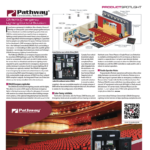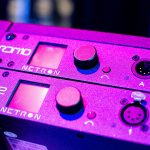Years ago, I was afraid of controlling my lights on a PC Based lighting controller. Recently, like in the past six months, I have come to fall in love with them. Looking back on why I was so nervous about using them was the fact that almost everything had to be done with a mouse, or by remembering those awkward keyboard shortcuts. There is something about having a console’s control surface in front of you.
The ah ha moment came to me recently that the real advantage of a lighting console is the ability to touch its screens and make something happen. In the early days of PC-based controllers, adding a touch screen monitor was something for the uber wealthy, as touchscreen monitors were outrageously overpriced. Now, you can pick a decent one up for under $200 dollars.

Going on tour with a PC-based controller is a fantastic idea. What do you need an entire control surface for if you are doing simple updates on site and running a pre-programmed show? ETC has been listening to their customers and recently launched a new “control surface” aimed at making a touring LD’s life simpler and their gear lighter in weight.
ETC’s Nomad Puck is a PC-based controller designed for the touring life. It is a small gray box, roughly 4 by 4 by 2 inches in size. Enclosed is a small PC optimized for exactly what you need to run ETC’s Eos or Cobalt control software. Unlike running the Eos or Cobalt family software on your laptop, The Nomad Puck is locked down on the software side. Meaning no one can install unwanted software while you are not looking or playing Space Invaders instead of getting some programming done.
Eos and Cobalt

The Nomad Puck can run either the Eos or Cobalt family of software, giving you more bang for the buck. Don’t think of it as just a single desk any more. Adding the Nomad Puck to your existing lighting network that is running either one of ETC’s family of controls, the Nomad Puck can run on the network as either a Primary, Backup or Client to your existing desk.
The Nomad Puck has a number of options within the software that are similar to the options available on ETC’s Eos and Cobalt family consoles. ETC offers a number of output counts with the Nomad Puck to find a cost-effective output count for your needs. Why get 2048 outputs when you only need 256? The output counts include 256, 512, 1024, 1536 and 2048. Of course, if your space or need for higher output counts increases over time, just like ETC’s consoles, the Nomad Puck can be upgraded at anytime with a purchase of additional outputs.
The Nomad Puck has a built in Ethernet port for communicating with ETC’s Net3 protocol as well as CAN/sACN and Art-Net. ETC notes, however, that the Nomad Puck does not support ETC Net2 Protocol. For 5-pin DMX output, there is an additional piece of hardware that is needed, the ETC Gadget, a USB-to-DMX Converter that can plug directly into the Nomad Puck.
 At a Glance
At a Glance
ETC Nomad Puck Product Features
• 256, 512, 1024, 1536 or 2048 outputs
• Nomad Puck 256 makes an ideal
tech-table RVI
• Operates in stand-alone, primary,
backup and client environments
• When connected as a client, output
capacity is determined by the system
to which it is connected
• Net3TM/ACN/sACN and Art-Net
Ethernet lighting protocols
• DMX via ETC Gadget
• DMX/RDM via Net3 DMX/RDM
Gateways
• Two HDMI ports
• Three USB ports


